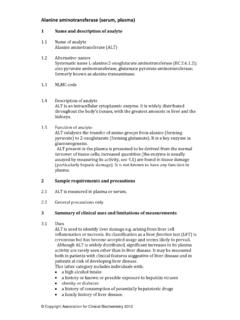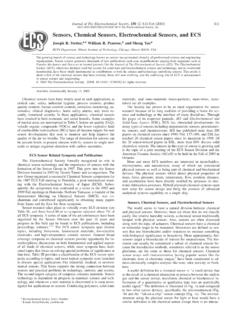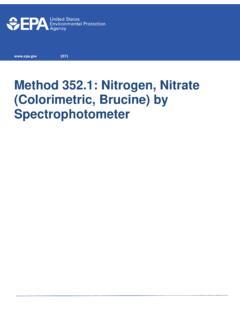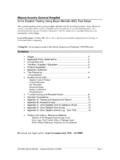Transcription of Content Sheet 7-1: Overview of Quality Control for ...
1 Quantitative QC Module 7 Content Sheet 1 Content Sheet 7-1: Overview of Quality Control for Quantitative Tests Role in Quality management system Quality Control (QC) is a component of process Control , and is a major element of the Quality management system. It monitors the processes related to the examination phase of testing and allows for detecting errors in the testing system. These errors may be due to test system failure, adverse environmental conditions, or operator performance. QC gives the laboratory confidence that test results are accurate and reliable before patient results are reported. This module explains how Quality Control methods are applied to quantitative laboratory examinations.
2 Overview of the process Quantitative tests measure the quantity of a substance in a sample, yielding a numeric result. For example, the quantitative test for glucose can give a result of 110 mg/dL. Since quantitative tests have numeric values, statistical tests can be applied to the results of Quality Control material to differentiate between test runs that are in Control and out of Control . This is done by calculating acceptable limits for Control material, then testing the Control with the patient s samples to see if it falls within established limits. As a part of the Quality management system, the laboratory must establish a Quality Control program for all quantitative tests.
3 Evaluating each test run in this way allows the laboratory to determine if patient results are accurate and reliable. Implementation process The steps for implementing a Quality Control program are: to establish policies and procedures; to assign responsibility for monitoring and reviewing; to train all staff on how to properly follow policies and procedures; to select good Quality Control material; to establish Control ranges for the selected material; to develop graphs to plot Control values; these are called Levey-Jennings charts; to establish a system for monitoring Control value; to take immediate corrective action if needed; to maintain records of Quality Control results and any corrective actions taken.
4 Organization Personnel Equipment Purchasing & Inventory Process Control Information Management Documents & Records Occurrence Management Assessment Process Improvement Customer Service Facilities & Safety Quantitative QC Module 7 Content Sheet 2 Content Sheet 7-2: Control Materials Defining Control materials Controls are substances that contain an established amount of the substance being tested the analyte. Controls are tested at the same time and in the same way as patient samples. The purpose of the Control is to validate the reliability of the test system and to evaluate the operator s performance and environmental conditions that might impact results.
5 Differentiating controls and calibrators It is important not to confuse calibrators and Control materials. Calibrators are solutions with a specified defined concentration that are used to set or calibrate an instrument, kit, or system before testing is begun. Calibrators are often provided by the manufacturer of an instrument. They should not be used as controls since they are used to set the instrument. Calibrators are sometimes called standards, but the term calibrator is preferred. They usually do not have the same consistency as patients samples. Characteristics of Control materials It is critical to select the appropriate Control materials.
6 Some important characteristics to consider when making the selection. Controls must be appropriate for the targeted diagnostic test the substance being measured in the test must be present in the Control in a measurable form. The amount of the analyte present in the controls should be close to the medical decision points of the test; this means that controls should check both low values and high values. Controls should have the same matrix as patient samples; this usually means that the controls are serum-based, but they may also be based on plasma, urine, or other materials. Because it is more efficient to have controls that last for some months, it is best to obtain Control materials in large quantity.
7 Types and sources of Control material Control materials are available in a variety of forms. They may be frozen, freeze-dried, or chemically preserved. The freeze-dried or lyophilized materials must be reconstituted, requiring great care in pipetting in order to assure the correct concentration of the analyte. Control materials may be purchased, obtained from a Quantitative QC Module 7 Content Sheet 3 central or reference laboratory, or made in-house by pooling sera from different patients. Purchased controls may be either assayed or unassayed. Assayed controls have a pre-determined target value, established by the manufacturer.
8 When using assayed controls the laboratory must verify the value using its own methods. Assayed controls are more expensive to purchase than unassayed controls. When using either unassayed or in-house or homemade controls, the laboratory must establish the target value of the analyte. The use of in-house controls requires resources to perform validation and testing steps. An advantage is that the laboratory can produce very large volumes with exact specification. Remember that Quality Control materials are usually serum-based. Universal precautions should be used when handling. Choosing controls When choosing controls for a particular method, select values that cover medical decision points, such as one with a normal value, and one that is either high or low, but in the medically significant range.
9 Controls are usually available in high , normal , and low ranges. Shown in the graphic are normal, abnormal high and low, and critical high and low ranges. For some assays, it may be important to include controls with values near the low end of detection. Preparing and storing Control material When preparing and storing Quality Control materials it is important to carefully adhere to the manufacturer s instructions for reconstituting and for storage. If in-house Control material is used, freeze aliquots and place in the freezer so that a small amount can be thawed and used daily. Do not thaw and re-freeze Control material.
10 Monitor and maintain freezer temperatures to avoid degradation of the analyte in any frozen Control material. Use a pipette to deliver the exact amount of required diluent to lyophilized controls that must be reconstituted. Quantitative QC Module 7 Content Sheet 4 Content Sheet 7-3: Establishing the Value Range for the Control Material Assaying Control over time Once the appropriate Control materials are purchased or prepared, the next step is to determine the range of acceptable values for the Control material. This will be used to let the laboratory know if the test run is in Control or if the Control values are not reading properly out of Control .















